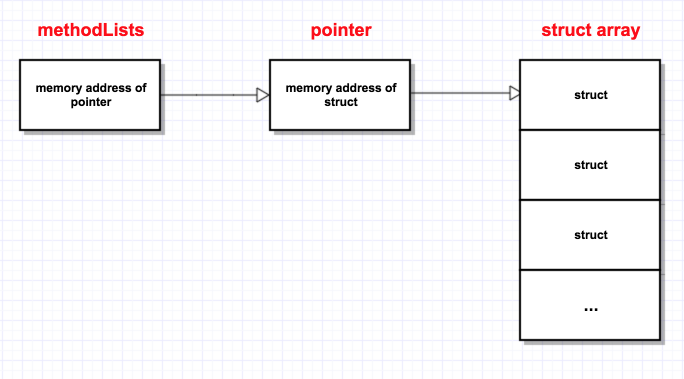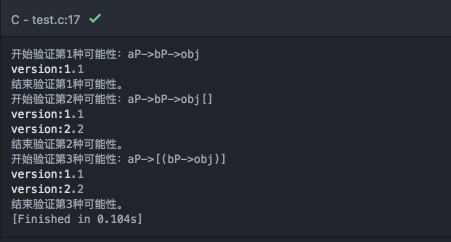1 2 3 4 5 6 7 8 9 10 11 12 13 14 15 16 17 18 19 20 struct objc_class { struct objc_class *isa; struct objc_class *super_class; const char *name; long version; long info; long instance_size; struct objc_ivar_list *ivars; #if defined(Release3CompatibilityBuild) struct objc_method_list *methods; #else struct objc_method_list **methodLists; #endif struct objc_cache *cache; struct objc_protocol_list *protocols; };
这是Objective-C 2.0中的类的代码,相信做iOS开发的同学都很熟悉的了。有天在查资料又看到它的时候,想到了一个好奇的问题:
methodLists 是一个二级指针,在内存中,它指向的是什么呢?(或者说,其指向的数据结构到底是怎么样的?)
然后,我想到了下面几个可能性:
methodLists 指向的是一个结构体的指针
methodLists 指向的是结构体数组的指针
methodLists 指向的是结构体指针数组
那么上面的可能性都是存在的吗?为了验证,我写了下面的代码进行测试。
1 2 3 4 5 6 7 8 9 10 11 12 13 14 15 16 17 18 19 20 21 22 23 24 25 26 27 28 29 30 31 32 33 34 35 36 37 38 39 40 41 42 43 44 45 46 47 48 49 50 51 52 53 54 55 #include <stdio.h> typedef struct { float version; } method; int main (int argc, char const *argv[]) { method **methodList; method aMethod; aMethod.version = 1.1 ; method bMethod; bMethod.version = 2.2 ; printf ("开始验证第1种可能性:aP->bP->obj\n" ); method *aMethodP = &aMethod; methodList = &aMethodP; method* currentMethod = *methodList; float version = currentMethod->version; printf ("version:%0.1f\n" ,version); printf ("结束验证第1种可能性。\n" ); printf ("开始验证第2种可能性:aP->bP->obj[]\n" ); method methodArray[2 ]; methodArray[0 ] = aMethod; methodArray[1 ] = bMethod; *methodList = methodArray; for (size_t i = 0 ; i < 2 ; i++) { method* currentMethod = &((*methodList)[i]); float version = currentMethod->version; printf ("version:%0.1f\n" ,version); } printf ("结束验证第2种可能性。\n" ); printf ("开始验证第3种可能性:aP->[(bP->obj)]\n" ); method* methodPointArray[2 ]; methodPointArray[0 ]=&aMethod; methodPointArray[1 ]=&bMethod; methodList = &(methodPointArray[0 ]); for (size_t i = 0 ; i < 2 ; i++) { method* currentMethod = *(methodList+i); float version = currentMethod->version; printf ("version:%0.1f\n" ,version); } printf ("结束验证第3种可能性。\n" ); return 0 ; }
运行结果如下:
按照上面提出的模型所编写的代码可以运行通过,这证明所说的3种可能性都存在,然而在runtime里使用的是哪种呢?
为此,特意去看了相关的代码,得到的答案是:第三种。
论据为:runtime中的class移除method的方法代码:
1 2 3 4 5 6 7 8 9 10 11 12 13 void class_removeMethods (Class cls, struct objc_method_list * meths) { _objc_removeMethods (meths, &((struct objc_class *) cls)->methodLists); flush_caches (cls, NO); }
1 2 3 4 5 6 7 8 9 10 11 12 13 14 15 16 17 18 19 20 21 22 23 24 void _objc_removeMethods (struct objc_method_list * mlist, struct objc_method_list *** list ){ struct objc_method_list ** ptr ; ptr = *list ; while (*ptr != mlist) { if ( *ptr == END_OF_METHODS_LIST ) return ; ptr += 1 ; } *ptr = 0 ; while (*(++ptr) != END_OF_METHODS_LIST) *(ptr-1 ) = *ptr; *(ptr-1 ) = 0 ; }
写在最后 那么对于标题提出的问题:『二级指针指向的数据结构是什么样的?』,它的标准答案是什么呢?
答案是:没有标准答案,它的答案应该是结合具体的业务代码来回答的,比如Runtime里的methodLists。
另外,在最后,不得不感叹下:指针真是C语言的灵魂,其让C变得何其灵活!(当然,同时也让C变得复杂,在你不知道作者的指针意图的时候)



